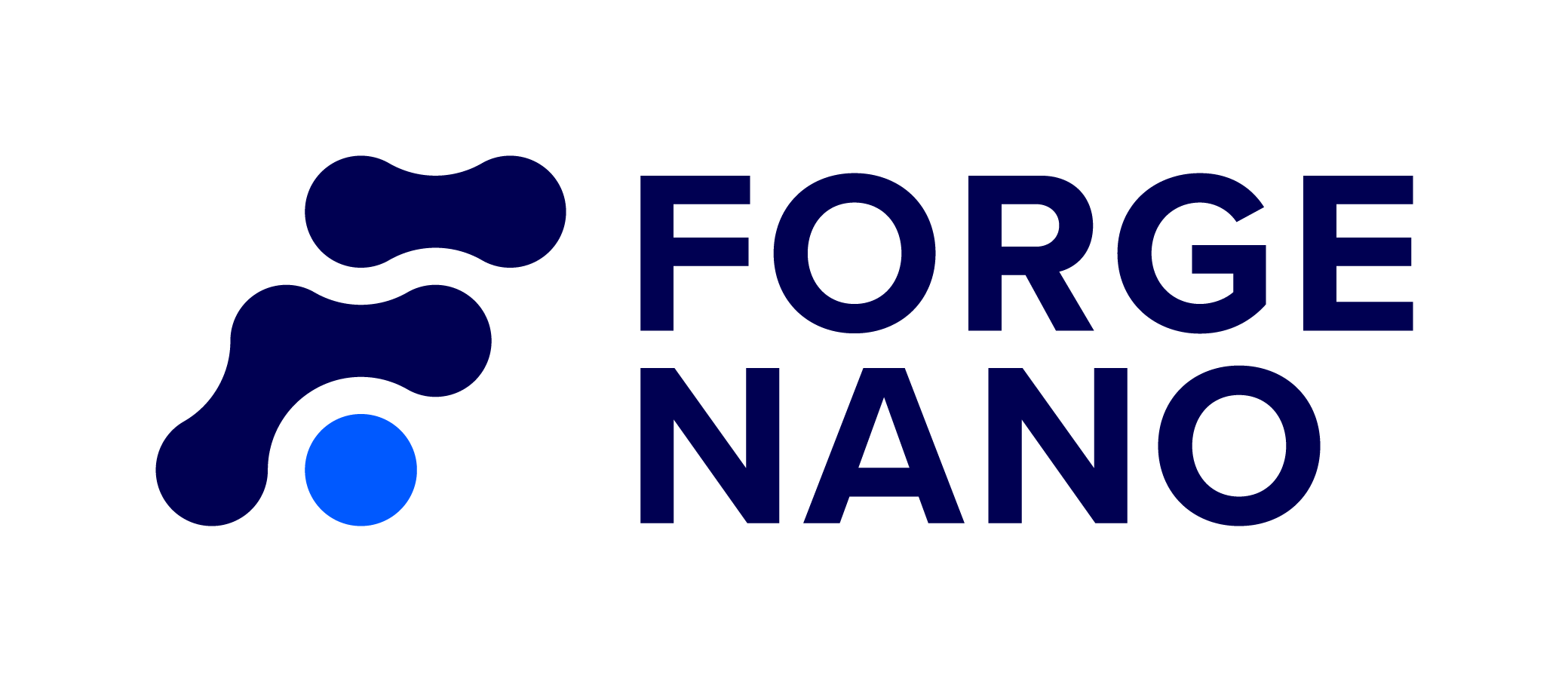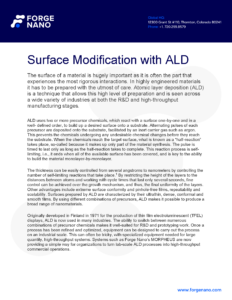SURFACE MODIFICATION

Surface Modification with ALD
The surface of a material is hugely important as it is often the part that experiences the most rigorous interactions. In highly engineered materials it has to be prepared with the utmost of care. Atomic layer deposition (ALD) is a technique that allows this high level of preparation and is seen across a wide variety of industries at both the R&D and high-throughput manufacturing stages.
ALD uses two or more precursor chemicals, which react with a surface one-by-one and in a well- defined order, to build up a desired surface onto a substrate. Alternating pulses of each precursor are deposited onto the substrate, facilitated by an inert carrier gas such as argon. This prevents the chemicals undergoing any undesirable chemical changes before they reach the substrate. When the chemicals reach the target surface, what is known as a “half-reaction” takes place, so-called because it makes up only part of the material synthesis. The pulse is timed to last only as long as the half-reaction takes to complete. This reaction process is self-limiting, i.e., it ends when all of the available surface has been covered, and is key to the ability to build the material monolayer-by-monolayer.
The thickness can be easily controlled from several angstroms to nanometers by controlling the number of self-limiting reactions that take place.1 By restricting the height of the layers to the distances between atoms and working with cycle times that last only several seconds, fine control can be achieved over the growth mechanism, and thus, the final uniformity of the layers. Other advantages include extreme surface conformity and pinhole-free films, repeatability and scalability. Surfaces prepared by ALD are characterized by their ultrathin, dense, conformal and smooth films. By using different combinations of precursors, ALD makes it possible to produce a broad range of nanomaterials.
Originally developed in Finland in 1971 for the production of thin film electroluminescent (TFEL) displays, ALD is now used in many industries. The ability to switch between numerous combinations of precursor chemicals makes it well-suited for R&D and prototyping work. Once a process has been refined and optimized, equipment can be designed to carry out the process on an industrial scale. This can often be tricky, with specialized equipment needed for large quantity, high-throughput systems. Systems such as Forge Nano’s MORPHEUS are now providing a simple way for organizations to turn lab-scale ALD processes into high-throughput commercial operations.
Applications of Particle ALD
Particle Atomic Layer Deposition (PALD) is the use of ALD to coat individual particles. By creating a near-perfect conformal coating, ALD can be used to drastically modify the properties of particles down to the sub-micron scale, presenting a number of potential near-term applications.2 One promising application area is in the improvement of the properties of polymer powders. High gas permeability of polymers limits their use in various food, medical and electronic packaging applications.3 Using ALD to coat polymer particles in an inorganic gas diffusion barrier – such as an ultrathin alumina layer – can dramatically improve polymer performance. Indeed, ALD has shown promise in functionalizing or passivating a range of particulate materials – including nanomaterials such as carbon nanotubes – in large quantities, helping to address one of the fundamental challenges in nanotechnology.4 Other applications of particle ALD include the modification of the rheological properties of suspensions of particles in the nanometer to micron range; modifying absorbance spectra in a variety of optoelectronic and piezoelectronic applications; and increasing the stability of catalysts.2,5,6
A number of high-profile industries have embraced and adapted ALD for their own use. One of the largest of these is the microelectronics industry, where it is used to build up high dielectric constant ceramics that make up the transistor gate stack in microelectronics devices.7 The ceramic oxides that make up the stack layers must be highly uniform and free of pinholes, so that there is no current leakage through it from the silicon underneath.
ALD is also applied in fields of optoelectronics, such as photovoltaics or solar panels.8 In these fields, ALD allows manufacturers to control the composition of a compound of three or more elements. This allows properties such as band gap, density, conductivity, energy band levels and morphology to be tuned with a high level of precision. The technique can be used in many parts of the photovoltaic, including passivation layers at the surface. This is similar to the way it is used in the transistor gate stack. By applying a custom Al2O3 layer to the front and back of the panel, the electronic losses are minimized and the efficiency of the cell improved.
Making ALD Scalable
Clearly ALD is well-suited to a number of tasks, at every scale of process. This ability for small scale R&D as well as large volume batch production was what Forge Nano had in mind when it developed its PROMETHEUS and MORPHEUS systems. The former is an R&D tool, designed to bring the power of particle ALD to the masses, while the latter is designed to allow these prototypes to be produced economically on large scales.
The PROMETHEUS system is an advanced platform that is designed to push forward the research into how sub-nano to nanoscale coatings may be applied to powders, making lab-scale ALD more attainable than ever before. It can handle powder volumes ranging from milligram to kilogram samples, with multiple reactor sizes available so that the batch size may be adjusted. Up to 8 precursors can be input at any one time, with gas, liquid and solid precursor recipes achievable through the basic and low vapor pressure delivery draw systems.
Where the PROMETHEUS system is designed to offer the ability to research and develop a coating process, the MORPHEUS system scales up this process to commercial levels. It maintains the same high precision nanoscale coating technology, but at industrial volume. MORPHEUS can be customized to suit your desired output from kilogram to kiloton, and by adopting a modular design, Forge Nano can work with you to tailor the platform to your specific needs.
About Forge Nano
Forge Nano is a leading materials science company harnessing the power of Atomic Armor, the company’s proprietary ALD nanocoating technology, to accelerate manufacturing innovation, transform product performance and achieve a more sustainable future for a range of industries around the world. Atomic Armor produces superior coatings that can unlock a material’s performance at the atomic level and deliver custom solutions from small-scale R&D and laboratory work to large-scale, high-volume production lines. A range of materials can be enhanced through Atomic Armor, including batteries, medical devices, catalysts, propellants and 3D additives. Forge Nano has received major support and signed meaningful partnerships with Volkswagen, LG Technology Ventures, Mitsui Kinzoku, Air Liquide and Sumitomo Corporation of Americas, largely as a result of the company’s innovation in the Lithium-ion battery industry and successful track record of improving product performance and safety while reducing cost.
Forge Nano’s Capabilities
- >20 in-house ALD systems for coating of wafers, powders and objects
- Including research, pilot and commercial scale systems capable of processing anywhere from 1.0 g to 30,000 kg powder or extrudates per day
- Fast deposition times up to 30nm per minute for rapid Al2O3 ALD coating solutions
- The world’s most knowledgeable and experienced team for ALD onto a range of materials
- PhD scientists, certified Professional Engineers, career scientists
- 20+ years’ experience designing and building powder ALD systems
Working with Forge Nano
Forge Nano assists customers daily with both R&D and commercialization of ALD-enabled materials. For R&D, we offer research services for proofs of concept and also sell our R&D equipment globally. For commercialization, we offer joint development of products, production equipment and IP licensing.
References and Further Reading
1. Pakkala, A. & Putkonen, M. Atomic Layer Deposition. in Handbook of Deposition Technologies for Films and Coatings 364–391 (Elsevier Inc., 2010). doi:10.1016/B978-0- 8155-2031-3.00008-9
2. Weimer, A. W. Particle atomic layer deposition. Journal of Nanoparticle Research 21, (2019).
3. Weaver, M. S. et al. Organic light-emitting devices with extended operating lifetimes on plastic substrates. Appl. Phys. Lett. 81, 2929–2931 (2002).
4. Cavanagh, A. S., Wilson, C. A., Weimer, A. W. & George, S. M. Atomic layer deposition on gram quantities of multi-walled carbon nanotubes. Nanotechnology 20, 255602 (2009).
5. Hakim, L. F. et al. Nanoparticle Coating for Advanced Optical, Mechanical and Rheological Properties. Adv. Funct. Mater. 17, 3175–3181 (2007).
6. Oneill, B. J. et al. Catalyst design with atomic layer deposition. ACS Catal. 5, 1804–1825 (2015).
7. Lee, F. et al. Atomic layer deposition: An enabling technology for microelectronic device manufacturing. in ASMC (Advanced Semiconductor Manufacturing Conference) Proceedings 359–365 (2007). doi:10.1109/ASMC.2007.375064
8. Delft, J. A. van, Garcia-Alonso, D. & Kessels, W. M. M. Atomic layer deposition for photovoltaics: applications and prospects for solar cell manufacturing. Semicond. Sci. Technol. 27, 074002 (2012).

